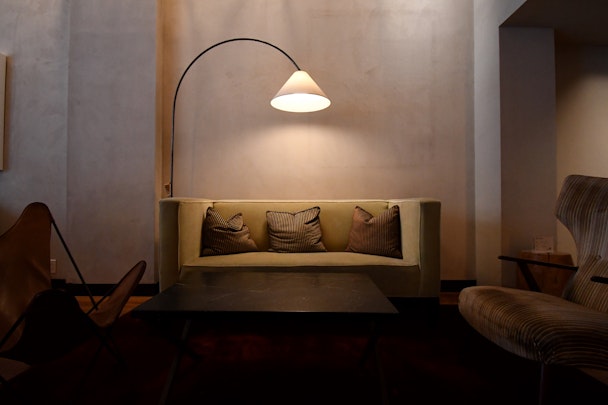Design classics: Jasper Morrison, simplicity and quiet
In design, as elsewhere, simplicity is often the most elegant solution. In the latest of his series on design geniuses, The Maverick Group's Andy Myring casts his eye upon British furniture designer Jasper Morrison.

A deep dive into the elegant simplicity of furniture designer Jasper Morrison / Max Harlynking via Unsplash
I’m writing this sitting on one of two identical chairs that I bought over 20 years ago. Made from a plywood frame, stainless-steel base and molded-leather upholstery, the chairs have the thickness of a typical ironing board and don’t look particularly comfortable.
Guests look horrified when I offer them these seats, but are pleasantly surprised by how comfortable they are. The size, cushioning, and angle of the seat and back: simply perfect.
Jasper Morrison designed the Low Pad chair in 1999 with the aim of making a “comfortable low chair, with as little volume as possible”. He was a fan of Poul Kjaerholm’s PK22 chair, admiring its elegance and minimal use of materials, but was not as impressed by its level of comfort.
Morrison has admitted that his early concepts for his new chair weren’t particularly exciting (a mix of steel frames and upholstery). By combining the profile of an airport bench with molded leather forms, he finally achieved the concept that he was after. Working with manufacturer Cappellini, Morrison found a company that made car seats with the production ability to press leather and most kinds of fabrics. The plywood panel was molded to the required profile, and Cappellini’s upholstery skills did the rest.
Morrison’s design work is restrained and reduced to the barest essentials. He designs objects that are so quietly functional that, to an untrained eye, they can look as if nobody designed them at all. This is Morrison’s trademark. He is the antidote to excess.
‘Simplicity’ is the philosophy Morrison adopted since he first emerged on the design scene in the mid-1980s; quietness is his thing. Designs so understated that they're almost silent: an approach that brought him huge success.
Advertisement
The origins of Morrison’s quiet design
Born in London, in 1959, Morrison’s pared-back aesthetic was forged early. He remembers the house where he grew up as “gloomy and a little bit claustrophobic”, with cluttered furniture, upholstery, and decoration making it feel overcrowded. These adornments made Morrison flee to a room that his grandfather had created. With a warm wood floor and good light, it was a place where Morrison felt comfortable and at home.
Morrison’s grandfather had acquired a taste for Scandinavian design while working at a Danish company. He applied this in his home, creating a space that was free of unnecessary decoration – a refuge for the young Morrison.
At the age of 16, Morrison visited Eileen Gray’s exhibition at London’s Victoria & Albert Museum and was inspired to train as a designer. He graduated from Kingston Polytechnic in 1982, before completing a master’s degree at the Royal College of Art and a one-year scholarship at the Berlin University of Arts.
In 1986, he founded his own design studio in London. Over 30 years later, his studios in Paris, Tokyo, and London are behind the designs for more than 600 objects from furniture, lightning, and kitchen dishes to door handles, taps and toilets.
Advertisement
An aversion to ostentation
Morrison believes that there's too much extravagant design in today’s consumerist world. The need for the new is relentless, with more and more items based purely on marketing. He thinks that design should not dominate but be unobtrusive and quietly functional. Successful design is remarkable in its simplicity, with discreet, composed charm.
In 2005, Morrison collaborated with Japanese designer Naoto Fukasawa on a ground-breaking exhibit which celebrated design's humbler side. With Super Normal, he reinterpreted the tried-and-tested, developing familiar solutions instead of relying on unusual shapes, colors, and materials.
The Tokyo-based exhibition focused on design that doesn't call attention to itself, but quietly exists as a normal part of life, such as a paperclip or pen. Morrison’s eponymous shop in Shoreditch carries hundreds of such well-designed household items from around the world.
Suggested newsletters for you
Morrison Inc
Over the course of his career, Morrison has created products for scores of companies: Muji, Camper, Lamy, Punkt, Vitra, Cappellini, Magis, APC, Flos, Mattiazzi and Maruni. Recently, he partnered with US brand Emeco, creating furniture like the 1 Inch Reclaimed Chair, from sustainably sourced materials. The Glo-Ball light series for Flos and the Maruni T chair are other stand-out projects.
Such products have won him plaudits in many shapes and forms. Morrison’s designs are represented in New York's Museum of Modern Art and other prominent collections worldwide. Since 2001, he has been an honorable member of the Royal Designers for Industry Association. In 2020, he was awarded a CBE in the UK and the Compasso D’Oro in Italy.
Together with his publisher Lars Muller, Morrison has written extensively about his design ethos in a series of books: A World Without Words, The Good Life, A Book of Things and Super Normal (with Naoto Fukasawa). Today, he's regarded as one of the world’s best designers thanks to his utilitarian and maverick approach.
Content by The Drum Network member:

The Maverick Group
WE HELP BRANDS UNLOCK THEIR MAVERICK POTENTIAL. In the battle for hearts and minds the Mavericks have the advantage. Those that know that it isn’t the size of...
Find out more
